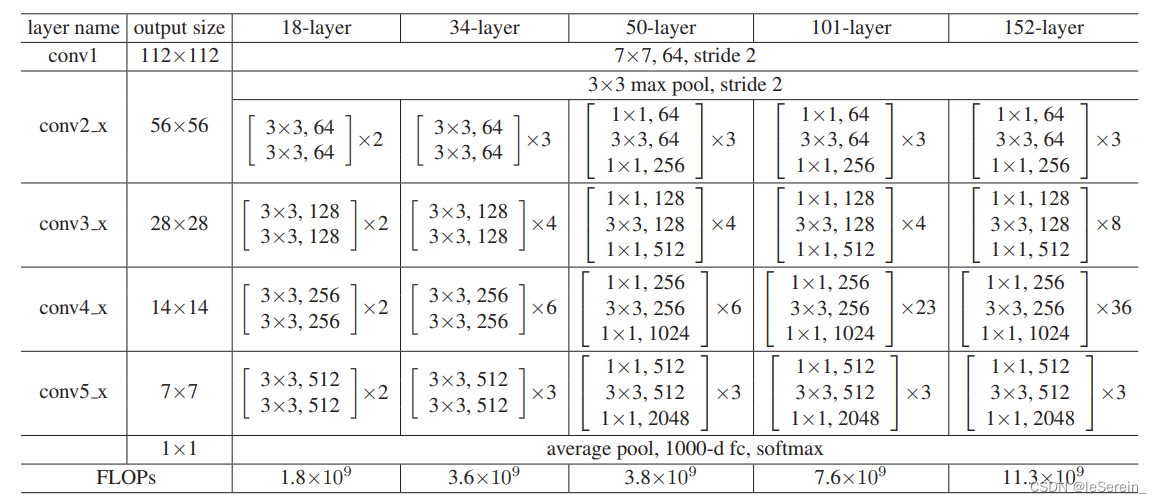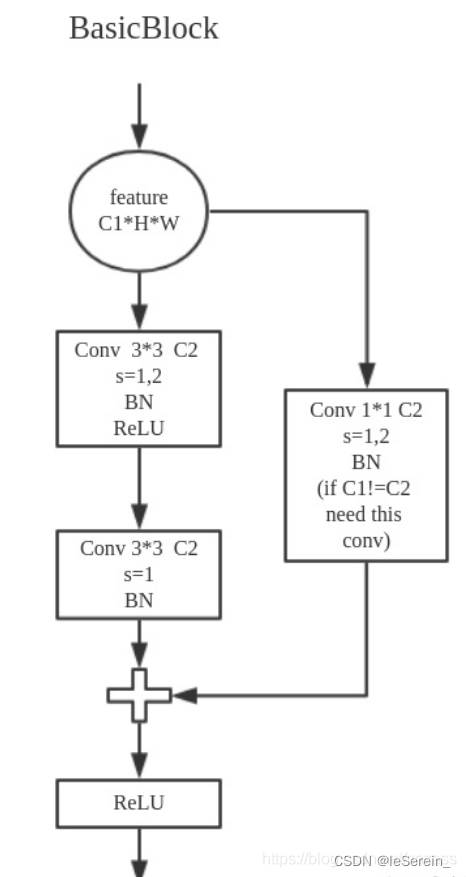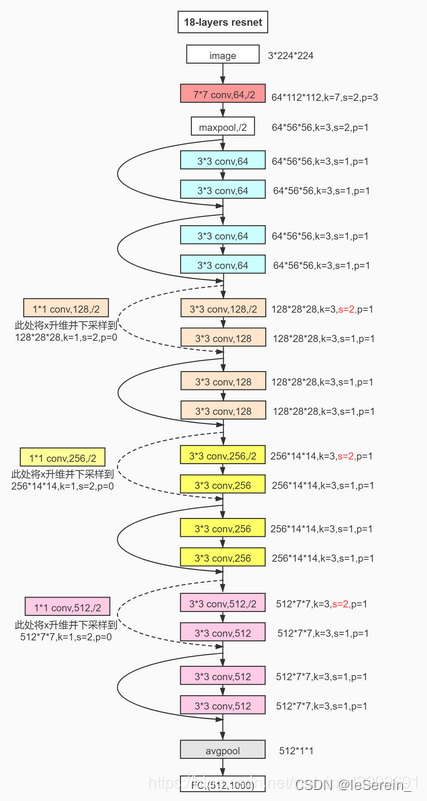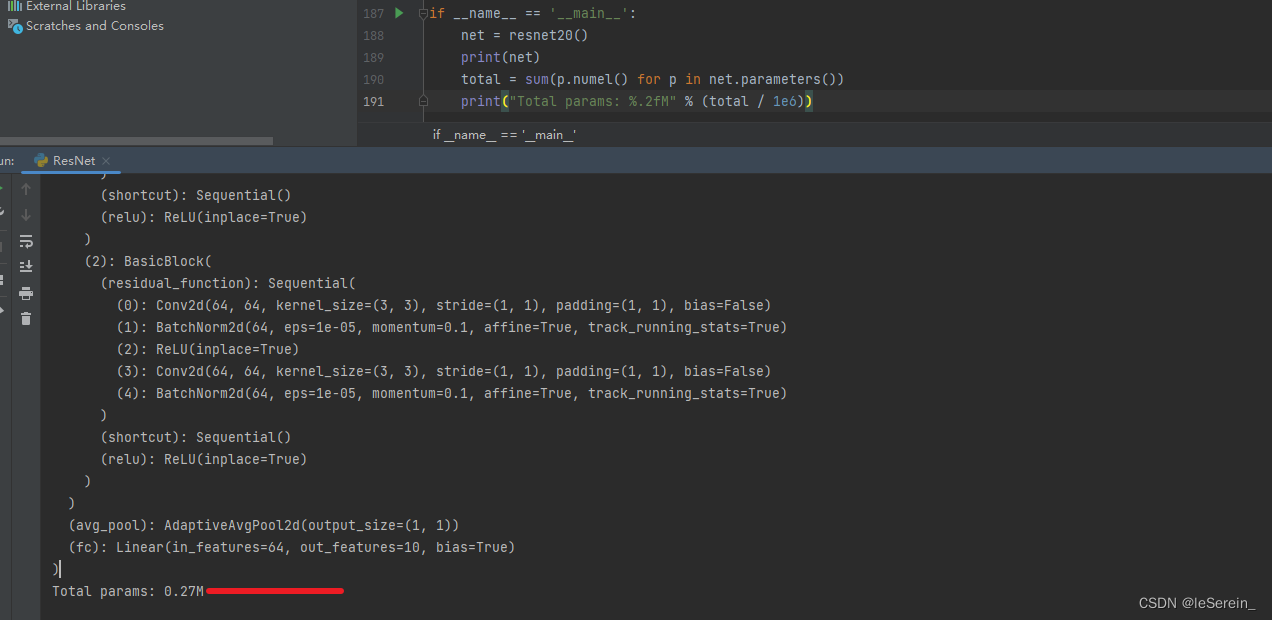文章目录
选取经典的早期Pytorch官方实现代码进行分析
https://github.com/pytorch/vision/blob/9a481d0bec2700763a799ff148fe2e083b575441/torchvision/models/resnet.py
各种ResNet网络是由BasicBlock或者bottleneck构成的,它们是构成深度残差网络的基本模块
ResNet主体

ResNet的大部分各种结构是1层conv+4个block+1层fc
classResNet(nn.Module):def__init__(self, block, layers, zero_init_residual=False):super(ResNet, self).__init__()
self.inplanes =64
self.conv1 = nn.Conv2d(3,64, kernel_size=7, stride=2, padding=3,
bias=False)
self.bn1 = nn.BatchNorm2d(64)
self.relu = nn.ReLU(inplace=True)
self.maxpool = nn.MaxPool2d(kernel_size=3, stride=2, padding=1)
self.layer1 = self._make_layer(block,64, layers[0])
self.layer2 = self._make_layer(block,128, layers[1], stride=2)
self.layer3 = self._make_layer(block,256, layers[2], stride=2)
self.layer4 = self._make_layer(block,512, layers[3], stride=2)
self.avgpool = nn.AdaptiveAvgPool2d((1,1))
self.fc = nn.Linear(512* block.expansion, num_classes)for m in self.modules():ifisinstance(m, nn.Conv2d):
nn.init.kaiming_normal_(m.weight, mode='fan_out', nonlinearity='relu')elifisinstance(m, nn.BatchNorm2d):
nn.init.constant_(m.weight,1)
nn.init.constant_(m.bias,0)# Zero-initialize the last BN in each residual branch,# so that the residual branch starts with zeros, and each residual block behaves like an identity.# This improves the model by 0.2~0.3% according to https://arxiv.org/abs/1706.02677if zero_init_residual:for m in self.modules():ifisinstance(m, Bottleneck):
nn.init.constant_(m.bn3.weight,0)elifisinstance(m, BasicBlock):
nn.init.constant_(m.bn2.weight,0)def_make_layer(self, block, planes, blocks, stride=1):
downsample =Noneif stride !=1or self.inplanes != planes * block.expansion:# normly happened when stride = 2
downsample = nn.Sequential(
conv1x1(self.inplanes, planes * block.expansion, stride),
nn.BatchNorm2d(planes * block.expansion),)
layers =[]
layers.append(block(self.inplanes, planes, stride, downsample))
self.inplanes = planes * block.expansion
for _ inrange(1, blocks):# only the first block need downsample thus there is no downsample and stride = 2
layers.append(block(self.inplanes, planes))return nn.Sequential(*layers)defforward(self, x):
x = self.conv1(x)
x = self.bn1(x)
x = self.relu(x)
x = self.maxpool(x)
c2 = self.layer1(x)
c3 = self.layer2(c2)
c4 = self.layer3(c3)
c5 = self.layer4(c4)
x = self.avgpool(x)
x = x.view(x.size(0),-1)
x = self.fc(x)return c5
需要注意的是最后的avgpool是全局的平均池化
BasicBlock
classBasicBlock(nn.Module):
expansion =1def__init__(self, inplanes, planes, stride=1, downsample=None):# here planes names channel numbersuper(BasicBlock, self).__init__()
self.conv1 = conv3x3(inplanes, planes, stride)
self.bn1 = nn.BatchNorm2d(planes)
self.relu = nn.ReLU(inplace=True)
self.conv2 = conv3x3(planes, planes)
self.bn2 = nn.BatchNorm2d(planes)
self.downsample = downsample
self.stride = stride
defforward(self, x):
identity = x
out = self.conv1(x)
out = self.bn1(out)
out = self.relu(out)
out = self.conv2(out)
out = self.bn2(out)if self.downsample isnotNone:
identity = self.downsample(x)
out += identity
out = self.relu(out)return out

图1. BasicBlock结构图
ResNet18

对应的就是[2,2,2,2]
defresnet18(pretrained=False,**kwargs):"""Constructs a ResNet-18 model.
Args:
pretrained (bool): If True, returns a model pre-trained on ImageNet
"""
model = ResNet(BasicBlock,[2,2,2,2],**kwargs)if pretrained:print('Loading the pretrained model ...')# strict = False as we don't need fc layer params.
model.load_state_dict(model_zoo.load_url(model_urls['resnet18']), strict=False)return model
ResNet34
defresnet34(pretrained=False,**kwargs):"""Constructs a ResNet-34 model.
Args:
pretrained (bool): If True, returns a model pre-trained on ImageNet
"""
model = ResNet(BasicBlock,[3,4,6,3],**kwargs)if pretrained:print('Loading the pretrained model ...')
model.load_state_dict(model_zoo.load_url(model_urls['resnet34']), strict=False)return model
ResNet20
这个需要强调一下,正常的ResNet20应该是文章中提出,针对cifar数据集设计的n=3时候, 1+6*3+1=20
classResNet4Cifar(nn.Module):def__init__(self, block, num_block, num_classes=10):super().__init__()
self.in_channels =16
self.conv1 = nn.Sequential(
nn.Conv2d(3,16, kernel_size=3, padding=1, bias=False),
nn.BatchNorm2d(16),
nn.ReLU(inplace=True))# we use a different inputsize than the original paper# so conv2_x's stride is 1
self.conv2_x = self._make_layer(block,16, num_block[0],1)
self.conv3_x = self._make_layer(block,32, num_block[1],2)
self.conv4_x = self._make_layer(block,64, num_block[2],2)
self.avg_pool = nn.AdaptiveAvgPool2d((1,1))
self.fc = nn.Linear(64* block.expansion, num_classes)def_make_layer(self, block, out_channels, num_blocks, stride):
strides =[stride]+[1]*(num_blocks -1)
layers =[]for stride in strides:
layers.append(block(self.in_channels, out_channels, stride))
self.in_channels = out_channels * block.expansion
return nn.Sequential(*layers)defforward(self, x):
output = self.conv1(x)
output = self.conv2_x(output)
output = self.conv3_x(output)
output = self.conv4_x(output)
output = self.avg_pool(output)
output = output.view(output.size(0),-1)
output = self.fc(output)return output
defresnet20(num_classes=10,**kargs):""" return a ResNet 20 object
"""return ResNet4Cifar(BasicBlock,[3,3,3], num_classes=num_classes)
我们通过参数量的计算也为0.27M,和论文中的一致,对[1,3,32,32]的输入,输出维度为[1,64,8,8]
图2 ResNet20参数量计算
但是也有一些文章只换了开头三层的3x3卷积层,通道数并没有采用16、32、64,仍是4层的64、128、256、512
,这样下来参数量是11.25M。针对的任务不同,但是如果不关注原始网络结构,这一点可以忽略。
Bottleneck Block
Bottleneck Block中使用了1×1卷积层。如输入通道数为256,1×1卷积层会将通道数先降为64,经过3×3卷积层后,再将通道数升为256。1×1卷积层的优势是在更深的网络中,用较小的参数量处理通道数很大的输入。
这种结构用在ResNet50、ResNet101中。
图2. Bottleneck 结构图
classBottleneck(nn.Module):
expansion =4def__init__(self, inplanes, planes, stride=1, downsample=None):super(Bottleneck, self).__init__()
self.conv1 = conv1x1(inplanes, planes)
self.bn1 = nn.BatchNorm2d(planes)
self.conv2 = conv3x3(planes, planes, stride)
self.bn2 = nn.BatchNorm2d(planes)
self.conv3 = conv1x1(planes, planes * self.expansion)
self.bn3 = nn.BatchNorm2d(planes * self.expansion)
self.relu = nn.ReLU(inplace=True)
self.downsample = downsample
self.stride = stride
defforward(self, x):
identity = x
out = self.conv1(x)
out = self.bn1(out)
out = self.relu(out)
out = self.conv2(out)
out = self.bn2(out)
out = self.relu(out)
out = self.conv3(out)
out = self.bn3(out)if self.downsample isnotNone:
identity = self.downsample(x)
out += identity
out = self.relu(out)return out
ResNet50

图3. ResNet50结构图
和以上的网络结构一样,把Bottleneck按层数堆起来就可以了
defresnet50(pretrained=False,**kwargs):"""Constructs a ResNet-50 model.
Args:
pretrained (bool): If True, returns a model pre-trained on ImageNet
"""
model = ResNet(Bottleneck,[3,4,6,3],**kwargs)if pretrained:print('Loading the pretrained model ...')
model.load_state_dict(model_zoo.load_url(model_urls['resnet50']), strict=False)return model
ResNet到底解决了什么问题
推荐看知乎问题Resnet到底在解决一个什么问题呢?
贴一些我比较喜欢的回答:
A. 对于
L
L
L层的网络来说,没有残差表示的Plain Net梯度相关性的衰减在
1
2
L
\frac{1}{2^L}
2L1 ,而ResNet的衰减却只有
1
L
\frac{1}{\sqrt{L}}
L1 。即使BN过后梯度的模稳定在了正常范围内,但梯度的相关性实际上是随着层数增加持续衰减的。而经过证明,ResNet可以有效减少这种相关性的衰减。
B. 对于“梯度弥散”观点来说,在输出引入一个输入x的恒等映射,则梯度也会对应地引入一个常数1,这样的网络的确不容易出现梯度值异常,在某种意义上,起到了稳定梯度的作用。
C. 跳连接相加可以实现不同分辨率特征的组合,因为浅层容易有高分辨率但是低级语义的特征,而深层的特征有高级语义,但分辨率就很低了。引入跳接实际上让模型自身有了更加“灵活”的结构,即在训练过程本身,模型可以选择在每一个部分是“更多进行卷积与非线性变换”还是“更多倾向于什么都不做”,抑或是将两者结合。模型在训练便可以自适应本身的结构。
D. 当使用了残差网络时,就是加入了skip connection 结构,这时候由一个building block 的任务由: F(x) := H(x),变成了F(x) := H(x)-x对比这两个待拟合的函数, 拟合残差图更容易优化,也就是说:F(x) := H(x)-x比F(x) := H(x)更容易优化. 举了一个差分放大器的例子:F是求和前网络映射,H是从输入到求和后的网络映射。比如把5映射到5.1,那么引入残差前是F’(5)=5.1,引入残差后是H(5)=5.1, H(5)=F(5)+5, F(5)=0.1。这里的F’和F都表示网络参数映射,引入残差后的映射对输出的变化更敏感。比如s输出从5.1变到5.2,映射F’的输出增加了1/51=2%,而对于残差结构输出从5.1到5.2,映射F是从0.1到0.2,增加了100%。明显后者输出变化对权重的调整作用更大,所以效果更好。残差的思想都是去掉相同的主体部分,从而突出微小的变化。
说法众多,好用就完事儿了嗷~
版权归原作者 leSerein_ 所有, 如有侵权,请联系我们删除。